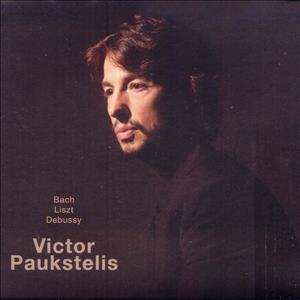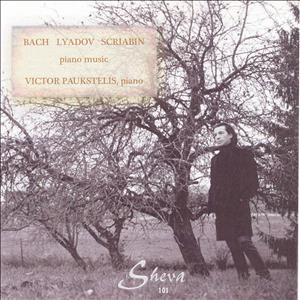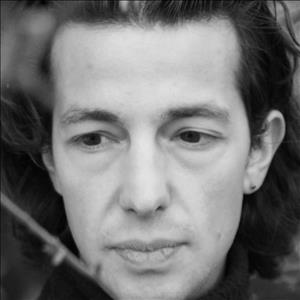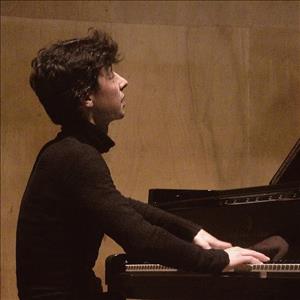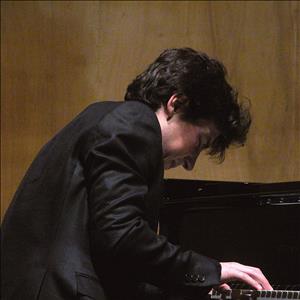
Viktoras Paukštelis

Performances
Salle Cortot Paris (2013), “Yamaha Centre de Paris” (2009, 2010) “Cite Internationale des Arts” (2010, 2011), Lithuanian Centre of Hamburg (2007) Kaunas Philharmonic (2004, 2011, 2012) Lithuanian Academy of Music and Theatre (2005, 2006, 2008, 2009, 2011, 2012, 2013), Klaipeda Concert Hall (2012), Birzai Festival with “Archi quartett” (2012), Lithuanian Chamber Orchestra (1995), Balys Dvarionas Music School Teacher Chamber Orchestra (2000).
Festivals and Competitions
Cite des Arts de Paris scholarship, France (2010); Albert Roussel scholarship Ecole Normale de Musique de Paris, France (2009); Musica Amabile Pianist Competition jury member Lithuania (2008); Accademia Internationale di Musica di Cagliari, Italy (2008); Yamaha Pianist Competition, Lithuania (2005); West Chester University, USA (2004);The International Holland Music Sessions Festival (2003); The Music Festival of Pite Alvdal, Sweden (2002, 2003); Verbier Festival and Academy, Switzerland (2002).
Academic Qualifications and Education
2009 - 2013 Ecole Normale de Musique de Paris. Student of Jean-Marc Luisada.
2009 Lithuanian Academy of Music and Theatre Licentiate of Arts Degree.
2007 Lithuanian Academy of Music and Theatre Master Degree. Student of Veronika Vitaitė.
2005 Hochschule für Musik und Theater Hamburg (exchange programme). Student of Evgeni Koroliov.
Lithuanian Academy of Music and Theatre Bachelor Degree. Student of Mariam Azizbekova.
2001 Balys Dvarionas Music School Diploma. Student of Tatjana Radovic.
1989 - 2000 Student of Donaldas Račys, Laimutė Jakniūnienė and Ema Miklaševskaja at National M. K. Čiurlionis School of Art.
Viktoras has been pursuing performance perfection in classes of Gary Graffman, Jiří Hlinka, Boris Petrushanskij, Michail Voskresenskij, Anthony di Bonaventura, Liu Hui-Ying Tawaststjerna, Tigran Alichanov and others.
Solo Works
Georg Friedrich Händel
Suite E Major, HWV 430
Johann Sebastian Bach
French suite No. 5 in G Major, BWV 816
English suite No. 3 in G-minor, BWV 808
English suite No. 6 in D-minor, BWV 811
Domenico Scarlatti
Sonata in D minor K.9
Sonata in E major K.380
Sonata in D minor K.141
Wolfgang Amadeus Mozart
Sonata B-dur, K.333
Fantasy in D Minor, K. 397
Fantasy in C Minor, K. 475
Frederic Chopin
Sonata No. 2 in B-flat Minor, Op. 35
Etudes op. 25
Scherzo no. 1 in B-minor, op.20
Franz Liszt
Mephisto Waltz No.1, S. 514
Sonata in B minor, S.178
Robert Schumann
Kinderszenen, Op.15
Cesar Franck
Prélude, Fugue et Variation, Op.18
Claude Debussy
Prelude No. 10 (Book II), „Canopic Jar“/ „Canope: Très calme et doucement triste“– Prelude No. 12 (Book II) , „ fireworks “/ „ Feux d'artifice “
Anatoly Ljadov
Prelude No. 1 in B-minor, Op. 11
Mazurka in A-major, Op. 15
Mazurka in A-minor, Op. 15
Bagatelle in B-flat minor (La Douleur), Op. 17
Bagatelle in B-major (Pastoral), Op. 17
Prelude No. 2 in B-flat minor, Op. 31
Muzikalnaya tabakerka (A musical snuffbox) in A-major, Op. 32
Three Pieces for piano: prelude, waltz, mazurka Op. 57
Four pieces for piano: Grimace, Gloom, Temptation, Reminiscences, Op. 64
Alexander Scriabin
Sonate No. 5, op. 53
Sonate No. 4 in F-sharp major, op. 30
Concertos
Wolfgang Amadeus Mozart
Piano concerto No. 23 In A-Major, K 488
Frederic Chopin
Concerto No. 2 in F- minor, Op. 21
Franz Liszt
Concerto No. 1, S. 124
Frédéric Chopin - Ballade No. 4 in F-minor, Op.52
F. Liszt - Piano Sonata in B minor, S 178
A. Scriabin etude No. 4 in F-sharp Major, Op. 42
D. Scarlatti sonata in D minor, K.9
V.Paukstelis is not interested in a traditional way of a performer, he goes the other way and to be more precise – his own way of a creator. He works quietly and persistently: looks for a key to the soul of the piece of music and for the optimal harmony between form and content until one and the other match becoming the worth of the pianist’s soul. This is achieved by a long, hard and invisible everyday work of the pianist peculiarly wrestling with the material until unambiguous, finite notes are transformed into a living creature with a distinctive character. Then the work speaks in a new and unexpected way, there is no distance between the music and the listener, the music erases the line between external (concert hall) and inner (soul) space, it even turns into something else - "naked" sound is not heard anymore because it becomes a medium to the more authentic reality – to the truth of being. Music "happens" here and now, the passage of time obeys a life pulse of the piece of music, and during the concert the piece that was nurtured for a long time is released into the wild - every time it speaks differently and in each hall and in each audience it unfolds differently. It's a little bit like Zen practice, when the shooter is no longer in control of an arrow actuated by the arc but the arc identifies itself with the action and using the archer shoots and, of course, hits. However, such freedom of the music piece is gained taking risks because work with the piano keyboard is not a momentary action.
V. Paukstelis can be called the pianist-adventurist: his music is a way of life, he plays for himself in the first place, so does not avoid unfamiliar concert halls in the province not knowing whether the audience will gather, what instrument and what acoustics of the hall will be. Once, said with a smile, lights during concert were going on and off, the next time he had to play the piano, the keys of which were at different heights…
However, let's go back to the last concerts and impressions. I attended two performances of the new program in Kaunas Philharmonic Hall and Vilnius Music Academy. Concerts sounded very differently, each had its own atmosphere, pulse and mood. I will stop by the newest impressions of the concert in Vilnius on 15 May.
Not only each piece individually, but also the concert as a whole had its progress and development, its acceleration, take-off and flight: in the first part started as a wrestling that was conquering the space of the audience, controlling the sound and making the instrument to obey the will of the pianist, in the second part he as though took another breath when the music was building a dialogue between the drama and the intent listening and closed the concert with etudes by Chopin and Scriabin of just a hurricane dynamism played encore. The first was Handel (Suite in E major, HWV 430) light, aristocratic, maybe a little monotonous at first, it increasingly drew into an elegant and joyous game, Handel was followed by Mozart's Fantasy in C minor, K. 475, which surprised by non-Mozart force and thoughtfulness, Beethoven (Sonata in E major, Op. 109, No. 30) – full of tension and controversy. The second part began by Scarlatti's Sonata in E major, K. 380 of remarkable subtlety and sensitivity, which pervaded the soul with the transparency of the sound. This was followed by Chopin's Ballade in G minor, Op. 26, No. 1 - a dramatic, painfully suggestive story of life conveying all the colours and nuances and was met by shouts "bravo"; it was again changed by the crystal-clear Scarlatti (Sonata in D minor, K. 9) - like a respite and dissolution. After it - Chopin again, Ballade in F minor, Op. 52, No. 4, not a story this time but captivating, picturesque waves and tides of emotions and secret whispers, and finally - anxious, rhythm-breaking Scriabin’s Sonata, Op. 53, No. 5 growing into an almost jazzy structure. However, encores became the top of the expression and the spree - totally separate elements - the pianist, the instrument, the music, the listener, time and space, merged into a single flight. The audience was enchanted.
This was achieved not only by virtuosity; it is inseparable from the maturity of the personality as well: though the pianist is often inspired by not a classical music – jazz and even rock; he especially appreciates work of Bobby McFerryn and Keith Jarret - still, his soul movement and self-identity he can "put in" only when pressing a key, without which it would sound just like an empty sound.
It is very tempting to wish for more people to discover and evaluate this exceptional music.
Tomas Kiauka, Thoughts after the recital of Viktoras Paukstelis, „7 Meno Dienos“ No.20 (942), 20/05/2011
If you were a witness of a piano concert which took place on the 3rd of May in the Lithuanian Academy of Music and Theater, you would surely not believe that the player, Viktoras Paukštelis, is only in his first year in the academy. The repertoire was something even a famous professional would be proud of – L. Van Beethoven‘s Sonata in As op.110, A.Scriabin‘s Sonata Nr.9 op.68 and so on. The student and grandchild of professor Marieta Azizbekova showed a really mature and undoubtful view on the music played. This young pianist is simply exceptional for his emotionalism, strong temper and concentration – it looks like he ignores the public, the piano and becomes one with the music which he so seriously plays.
Not only can you spot his individuality with your inside detectors, you can also see it – Viktoras sits very low and sometimes even conducts with his free hand. One can see an influence of the famous pianist Glen Gould, but this similarity may only be seen on the surface and does not interfere with Viktoras‘ abilities or choices he makes.
The interpretation of J.S.Bach‘s French Suite Nr.5 in G was very creative, especially the Sarabanda and Loure. Probably the most difficult part for pianists is the third movement (Adagio ma non troppo) of the earlier mentioned sonata by L. Van Beethoven, which is actually one of the most appreciated masterpieces of the composer. So the third movement is the musical space where the composer, as was said by R.Rolland, used the principles of a fuga and he did that pretty geniously – by tactically and emotionally building a complex construction of hot temper and growing musical power. That‘s why this movement and the „not-as-simple-as-they-look“ phylosophical grounds of it make the whole piece a difficult task for a performer. It was a real pleasure watching and hearing Viktoras do his wonderful job completing that task in his own exceptional way.
V.Paukštelis turned into a complete romantic whilst playing two rhapsodies by J.Brahms, a soft and pleasant sound was achieved in the performance of F.Chopin‘s Nocturno Nr.1 in f op.55, a great octave tehcnique was demonstrated in Etude Nr.10 op.25 also by Chopin.
Scriabin‘s Sonata Nr.9 op.68 was written in the latest creative period and this piece involves extremely complex variety of associations. An existing mystery was felt in legedaire, also some dark allegories. Then it was a light flash of sincere hope and the whole thing was generalized by a tornado of clear gruesome evil. In order to understand and convey these and other parts of this complicated piece, a performer should have most Scriabin‘s pieces in his pocket even before opening the piano score of this sonata. If your pockets do not contain any earlier pieces of Scriabin – you may find it very difficult to manage the specific microrhytmics, to „enter“ Scriabin‘s world of colours and lights, to maintain the base of the musical sound content by operating a problematic pedal technique.
On the whole, Viktoras‘ interpretations left a clear and unforgettable picture in the heads of the concert public. Great planning, precisely analized structural content, strong culminations and very, very intense emotions. Probably one of the most convincing parts of his interpretations were the lyrical motives – they were mature, colourful and really moody in the way of variety.
The public demanded a bis of S.Rachmaninov‘s Etude-Portrait Nr.6 in cis op.33. This piece was also performed in a particularly emotional and enthusiastic manner.
V.Paukštelis is only at the beginning of his public recognition path. I am absolutely and positively sure that Viktoras‘ exceptional tallent and his vastly creative approach will lead to great success. And I haven‘t experienced a so strong emotional performance in years.
